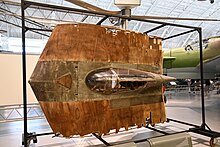Hoarding H III
| Hoarding III | |
|---|---|

|
|
| Type: | Glider / motor glider |
| Design country: | |
| Manufacturer: |
Horten brothers |
| First flight: |
1935 |
| Production time: |
1939–? |
| Number of pieces: |
19th |
The Horten H III is a flying wing aircraft that was developed by the brothers Reimar and Walter Horten .
history
For the Rhön competition in 1938, the brothers wanted to compete with a new, improved type of aircraft. So two machines, called H III a and c, were created, one of which was temporarily equipped with a small auxiliary wing above the arrowhead. The machines of the type H III showed good properties, but both were broken by hailstorms in a cloud flight . Both machines had reached a height of more than 8000 m in the storm cloud. While the pilot Heinz Scheidhauer survived with severe frostbite , Werner Blech was killed in the flight with the H III c.
Nevertheless, the Horten III, with 19 units built, was to become the main type of Horten flying wings. The different sub-versions are:
- H III a - single item, even with a slimmer outer wing (D-12-348).
- H III b - production model, ten built.
- H III c - single piece with slat (D-12-347).
- H III d - one-off, motor glider with Walter Mikron engine , internally called "Butterfliege".
- H III e - single item, motor glider with VW engine and folding propeller.
- H III f - prone pilot position, two built.
- H III g - two-seater, two built.
- H III h - single item, two-seater.
For the later models, some assemblies of the ten H III b were used. The wingspan of all H III was 20.4 meters and the wing was equipped with a moment-free hoarding S- flap profile in the middle and a symmetrical profile on the outside.
The wing was geometrically twisted from half the span according to Horten's bell-shaped lift distribution. It was controlled via subdivided elevons on the outer wing with differently superimposed functions. Nose spreading flaps on the wing tips served as rudders. A folding propeller was used for the first time on the H III e motor glider. The structure generally corresponded to that of the Horten H II . Only one H IIIf and the unrestored middle section of the two-seater H IIIh in the USA have survived.
Production was likely to have been planned until 1944 and beyond, as documents from the holdings of the Rheinisch Westphalian Economic Archives in Cologne suggest. Whether the Horten III was actually produced in 1944/45 is doubtful due to the war situation.
Technical specifications
| Parameter | Data |
|---|---|
| crew | 1 |
| length | |
| span | 20.5 m |
| height | |
| Wing area | 36 m² |
| Wing extension | 11.6 |
| Nose arrow | 24.3 ° |
| Glide ratio | ~ 27 at 75 km / h |
| Empty mass | 300 kg (glider) 350-360 kg (motor glider) |
| Max. Takeoff mass | 360-460 kg |
| Wing loading | 11.3 kg / m² |
| Minimum speed | 45-50 km / h |
| Top speed | 210 km / h |
See also
literature
- Reimar Horten, Peter F. Selinger: Nurflügel, the history of the Horten aircraft 1933-1960. H. Weishaupt Verlag, Graz, ISBN 3-900310-09-2 .
- Karl Nickel , Michael Wohlfahrt: Tailless Airplanes. Their design and properties. Birkhäuser Verlag, Basel et al. 1990, ISBN 3-7643-2502-X .



